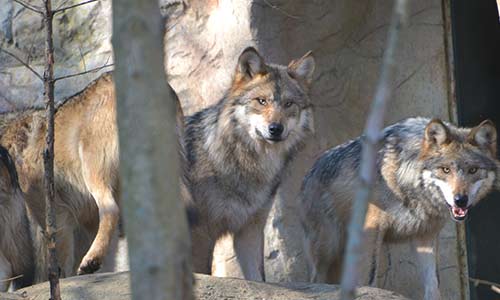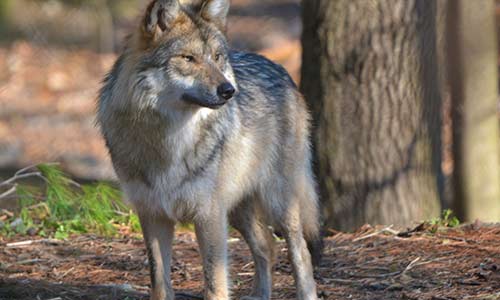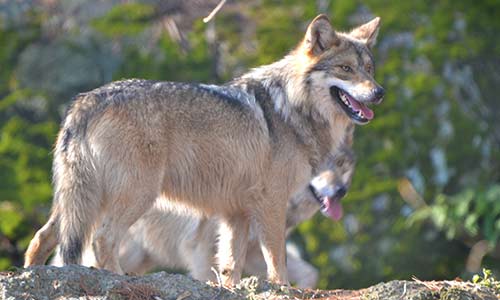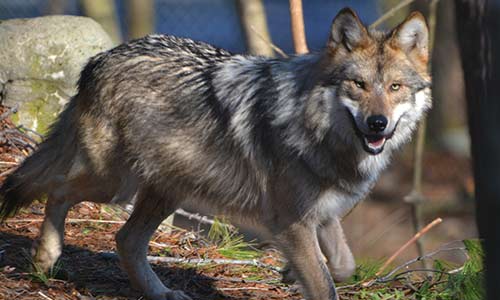The pack is back at Stone Zoo!
Tuesday April 21, 2020
While Stone Zoo may be closed to the public right now due to COVID-19, the care continues. Our dedicated animal care team is onsite daily working tirelessly to provide the expert, professional care that our animals always receive.
In early March, Stone Zoo welcomed several new furry faces to the animal family with the arrival of six Mexican gray wolf brothers from the Wolf Conservation Center in New York. The 1-year-old brothers were introduced to their expansive, wooded exhibit for the first time on April 17.
“The wolves are a bit shy, but are settling in well. These wolves are young and very active. They have checked out the entire exhibit, which was easy to see with all of the footprints after the snow this past Saturday,” said Pete Costello, Assistant Curator of Stone Zoo. “Craighead, the runt of the litter, is especially curious and comes right to the front of the exhibit to check things out.”
The wolves, who were named in honor of female conservationists, are named Craighead, Mittermeier, Lek, Carson, Goodall and Beattie.
“Zoo New England is committed to the conservation of this incredible species and is proud of the role we have played in ensuring the success of this reintroduction program that began 22 years ago. Our Mexican zoo colleagues joined the coordinated effort several years ago, and now wild wolves are living and reproducing on both sides of the border,” said John Linehan, Zoo New England President and CEO. “We look forward to the day when our visitors can see these brothers in person and have the opportunity to learn more about this iconic, yet often misunderstood, species. We hope that people are staying connected to us through our social media channels where we are sharing regular updates about the animals.”
For more than 20 years, Zoo New England has been committed to the conservation of Mexican gray wolves. ZNE’s Stone Zoo is a longtime participant in the Mexican Gray Wolf Species Survival Plan (SSP), a cooperative, inter-zoo program coordinated nationally through the Association of Zoos and Aquariums (AZA). SSPs help to ensure the survival of selected species in zoos and aquariums, most of which are threatened or endangered, and enhance conservation of these species in the wild. Additionally, in a unique partnership between the U.S. Fish and Wildlife Service, state agencies, several zoos accredited by AZA and other partners, ZNE participates in a reintroduction program to release captive-reared Mexican wolves in remote parts of Arizona, New Mexico and the country of Mexico.
Once common throughout western Texas, southern New Mexico, central Arizona and northern Mexico, the Mexican gray wolf, the rarest and most genetically distinct subspecies of the North American gray wolf, was completely eliminated from the wild, surviving in only small captive populations. In 1976, the Mexican gray wolf, also known as the lobo, was listed as endangered under the Endangered Species Act. The Mexican wolf recovery team was formed, and, as required, a conservation and survival plan was established in 1979. Today, there are 163 Mexican gray wolves in Arizona and New Mexico – a 24 percent increase over the 131 wild Mexican gray wolves surveyed in 2018.
Mexican gray wolves weigh between 50 and 80 pounds and are about 5-feet long with a relatively large head. The coat is often mottled or patchy and varies from gray and black to brown and buff. Mexican gray wolves have complex social behavior, which includes living in tightly organized packs and communicating through howling vocalizations, body posturing and scent marking. These animals work effectively together to adapt to most environments where there is prey, which includes deer, jackrabbit, mice and peccary.
Stone Zoo has not exhibited Mexican gray wolves since October 2019 when Roberto, the last remaining member of the previous pack, passed away from age-related health issues.











